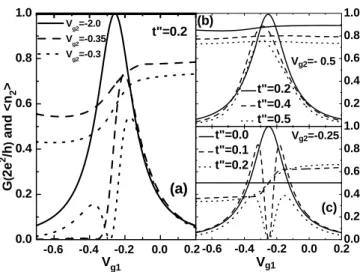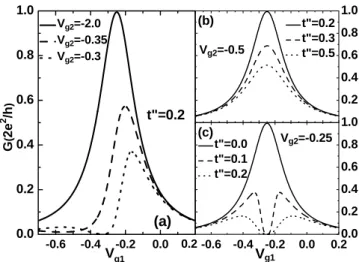Brazilian Journal of Physics, vol. 36, no. 3B, September, 2006 817
Transport Properties of Strongly Correlated Electrons in Quantum Dots Using
a Simple Circuit Model
G. B. Martinsa, C. A. B¨usserb, K. A. Al-Hassaniehb, E. V. Andac, A. Moreoband E. Dagottob aDepartment of Physics, Oakland University, Rochester, MI 48309, USA
bUniversity of Tennessee, Knoxville and Condensed Matter Sciences Division, Oak Ridge National Laboratory, Oak Ridge, Tennessee 37831, USA
cDepartamento de F´ısica, Pontif´ıcia Universidade Cat´olica do Rio de Janeiro, 22453-900, Brazil
Received on 08 December, 2005
Numerical calculations are shown to reproduce the main results of recent experiments involving nonlocal spin control in nanostructures (N. J. Craiget al., Science304, 565 (2004)). In particular, the splitting of the zero-bias-peak discovered experimentally is clearly observed in our studies. To understand these results, a simple “circuit model” is introduced and shown to provide a good qualitative description of the experiments. The main idea is that the splitting originates in a Fano anti-resonance, which is caused by having one quantum dot side-connected in relation to the current’s path. This scenario provides an explanation of Craiget al.’s results that is alternative to the RKKY proposal, which is here also addressed.
Keywords: Kondo effect; Nanoscopic systems; Correlated electrons
In this Letter, numerical simulations in good agreement with the experiments reported by Craig et al. [1] are pre-sented. The central conclusion of this work is that Fano anti-resonance ideas are essential to explain this experimental re-sults. Although the study of transport properties including current noise[6] of a microscopic quantum model is the most common way to understand nanoscopic transport, we will in-stead explain the experiments using a a very simple “circuit model”, where one of the elements is a T-connected QD that has an intrinsic reduction of conductance with varying biases. Fig. 1a depicts the experimental set up used in the
measure-S=0 S=1/2 QD2
QD1 CR or
U t’ t’
QD2
QD1 U
t"
t b
CR
FIG. 1: (a) Experimental setup used in Ref. [1]. (b) Illustration of the model studied in this Letter (see text for details).
ments [1] with the labeling used in this Letter. Figure 1b is a schematic representation of the system, introducing two dif-ferent tunneling parameters (hopping matrix elementst′ and t′′) and the Coulomb repulsion U in each QD (assumed the same for simplicity). To model this system, the Anderson im-purity Hamiltonian is used for both QDs. To calculate the
conductanceG, using the Keldysh formalism [2], a cluster containing the interacting dots and a few sites of the leads is solved exactly[3], the Green functions are calculated, and the leads are incorporated through a Dyson Equation embedding procedure. Details of the embedding have been extensively discussed before[4]. All the results shown were obtained for U=0.5,t
′=0
.2, zero-bias, and zero temperature.
0.2 0.4 0.6 0.8 1.0
-0.6 -0.4 -0.2 0.0 0.20.0 0.2 0.4 0.6 0.8 1.0
-0.6 -0.4 -0.2 0.0
0.0 0.2 0.4 0.6 0.8 1.0
Vg2=- 0.5
t"=0.2 t"=0.4 t"=0.5
(b)
Vg1
(c) Vg2=-0.25 t"=0.0
t"=0.1 t"=0.2 Vg2=-2.0
Vg2=-0.35
Vg2=-0.3
t"=0.2
G
(
2e
2 /h
)
and <n
2
>
Vg1
(a)
0.2
FIG. 2: Numerical results obtained at (a) fixedt′′and varyingVg2, and for fixedVg2 with varyingt′′for two different occupancies of QD2: (b) close to two electrons and (c) close to one electron. See text for details.
818 G. B. Martins et al.
now depends onVg1. In addition,Gdecreases in comparison to the result obtained forVg2=−2.0. Then, these numerical results are qualitatively in agreement with the experimental results shown in Fig. 2 of Craig et al. [1], namely, by de-creasing the occupancy of QD2, from even to odd number of electrons, the zero-bias anomaly (ZBA) in QD1 is suppressed. AsVg2is further increased (−0.3) aqualitativechange occurs: For values ofVg1 wherehn2i ≈0.5 (QD2 singly occupied), the conductance of QD1 vanishes and therefore there is a nar-row dip inG. This splitting of the ZBA is remarkably similar to that observed in Fig. 3A of the experimental results[1]. For finite-temperature calculations, the dip inGwill not reach zero, resembling even better the experiments[?].
To further test the similarities between simulations and ex-periments, in Figs. 2b and 2c results for G and hn2i are shown for fixedVg2and differentt′′values. In Fig. 2b, where Vg2=−0.5, ast
′′ increases from 0
.2 to 0.5 there is only a slight decrease ofG. This is accompanied by a slight decrease in the average value of hn2i, from ≈0.9 to ≈0.7. A more dramatic change is obtained in Fig. 2c, whereVg2=−0.25, andt′′varies from 0.0 to 0.2. By increasingt′′from 0.0 (red curves) to 0.1, the ZBA is now split in two andhn2iacquires a dependence onVg1. Ast′′further increases (0.2), the dip be-comes wider, the two side-peaks decrease andGstill vanishes forhn2i=0.5 (one electron in QD2). Our calculations show that, ifhn2ivaries around 0.5, the dip inGis present for all finite values oft′′, with a width proportional tot′′. Comparing the results in Figs. 3A and 3B of Craiget al.[1] with Figs. 2c and 2b in this Letter, respectively, one notices a striking simi-larity: The splitting of the ZBA observed in the experimental results (their Fig. 3A), when the number of electrons in the control QD is odd and the coupling to the central region is in-creased, is very similar to the dip inGfor all finite-t′′curves in Fig. 2c (as mentioned above, at finite temperatures, one expects that the dip inGwill not reach zero). When the occu-pancy of QD2 is even (Fig. 3B in the experimental results [1] and Fig. 2b in this Letter), theGdependence ont′′ is much less significant and the splitting of the ZBA does not occur.
QD1 QD2
)
)
)
R L
QD2 QD1
R L
FIG. 3: Schematic representation of the main ideas behind the “cir-cuit model”. See text for details.
What is the origin of these results? Below, it will be argued that a qualitative description of the results can be achieved by analyzing the two quantum dots through a so-called ‘cir-cuit model’. This model starts with the conductance of each QD calculated separately, as independent elements of a
cir-cuit, and then the conductance of the ‘complete circuit’ is ob-tained by combining the conductances of the two elements connected in series. Fig. 3 describes schematically the steps involved in this approach. In Fig. 3a, the complete system formed by QD1 and QD2 (shown in Fig. 1b) is divided into two components. QD1 is modeled as a QD connected directly to left (L) and right (R) leads, while QD2 is modeled as a side-connected QD[7]. Fig. 3b shows the respective conduc-tances and occupancies for each independent element vs. gate voltage, and Fig. 3c represents the scattering processes (rep-resented by transmission and reflection amplitudes) that an electron undergoes while moving through the complete ‘cir-cuit’. The superposition of all these processes leads to the total transmittance (proportional to the conductance) for the circuit model. This can be calculated in two ways: coher-ently or incohercoher-ently[8]. Since there is no qualitative differ-ence between them, and in order to keep the simplicity of the model, we present the incoherent results. The equation which provides the final transmittance for the processes depicted in Fig. 3c is
T = T1T2 1−R1R2
, (1)
where the transmittancesT1 and T2 are proportional to the conductances for QD1 and QD2, as depicted in Fig. 3b, and R1(2) =1−T1(2) are the reflectances. To calculate T, one needs to establish howT2depends onVg1. The natural way to do that is to use the dependence ofhn2ionVg1, as depicted in Fig. 2, and then use the relation between conductance and oc-cupancy, as shown in the red curves in Fig. 3b. In other words, the functional relation can be expressed asT2=T2(hn2i(Vg1)). It is not surprising that in a strongly correlated system like the one being analyzed here, the variation of the gate potential of QD1 will influence the charge occupancy of QD2, and in turn this will influence the conductance through QD1.
-0.6 -0.4 -0.2 0.0
0.0 0.2 0.4 0.6 0.8 1.0
0.2 0.4 0.6 0.8 1.0
-0.6 -0.4 -0.2 0.0 0.20.0
0.2 0.4 0.6 0.8 1.0
(a) t"=0.2
G
(
2e
2 /h
)
Vg1 Vg2=-2.0
Vg2=-0.35
Vg2=-0.3
0.2
Vg2=-0.25 (b)
Vg2=-0.5
t"=0.2 t"=0.3 t"=0.5
(c)
Vg1 t"=0.0 t"=0.1 t"=0.2
FIG. 4: Same as in Fig. 2, but now using the ‘circuit model’ for the calculations.
Brazilian Journal of Physics, vol. 36, no. 3B, September, 2006 819
agreement varies, there is good overall qualitative agreement. All the trends are correctly reproduced and some of the details are quite similar, such as for example the asymmetric shape of the curves at higher values ofVg2(−0.35 and−0.3) in Fig. 4a. The success of the circuit model implies that the dip in Garises from the Fano anti-resonance which cancels the con-ductance of QD2 (red solid curve in Fig. 3b). The Fano anti-resonance can be seen as a destructive interference process be-tween two different trajectories an electron can take on its way to QD1: it can cross the CR without passing through QD2; or it can visit QD2, return to the CR and then proceed to QD1 [7].
In the following, just a brief account is given of the im-portance of the RKKY interaction in the experimental setup being discussed. The authors found out that (as expected) thereis a coupling between QD1 and QD2 which seems to have the characteristics of an RKKY interaction. However, by redoing the conductance calculations with the Hubbard
inter-action in QD1 set to zero, where any long range interinter-action between QD1 and QD2 vanishes, the splitting of the conduc-tance peak is not affected, indicating that its origin can be fully ascribed to the interference process described above. In sum-mary, the numerical results qualitatively reproduce the main aspects of important recent experiments [1] involving nonlo-cal spin control in nanostructures. The main result is that the splitting observed in the ZBA is caused by a cancellation in the conductance due to a destructive interference. This so-called Fano anti-resonance has its origin in one of the dots being side-connected to the current’s path. A simple ‘circuit model’ qualitatively reproduces the experiments and offers an alterna-tive to a purely RKKY interpretation of the results, underscor-ing that a laboratory realization of the two-impurity Kondo system should avoid any geometry susceptible to a Fano anti-resonance.
C.B., K. A., A. M., and E. D. are supported by NSF grant DMR 0454504. G. M. by an OU internal grant.
[1] N. J. Craig , J. M. Taylor, E. A. Lester, C. M. Marcus, M. P. Hanson, and A. C. Gossard, Science304, 565 (2004).
[2] Y. Meir, N. S. Wingreen, and P. A. Lee, Phys. Rev. Lett.66, 3048 (1991).
[3] Results shown include one site on each side. Calculations with more sites were done, but no significative size-effects were ob-served.
[4] See V. Ferrari, G. Chiappe, E. V. Anda, and M. A. Davidovich, Phys. Rev. Lett.82, 5088 (1999).
[5] Removing QD2 results in essentially the same conductance as the one forVg2=−2.0.
[6] A. L. Yeyati, F. Flores, and E. V. Anda, Phys. Rev. B47, 10543 (1993).
[7] R. Franco, M. S. Figueira, and E. V. Anda, Phys. Rev. B67, 155301 (2003); M. Satoet al., cond-mat/0410062.

